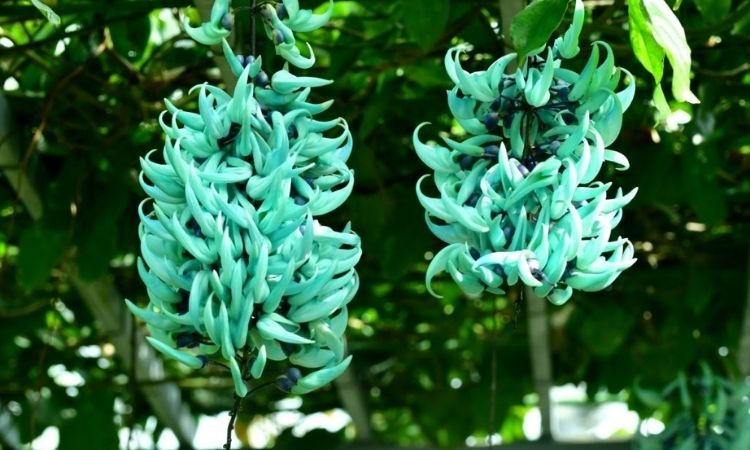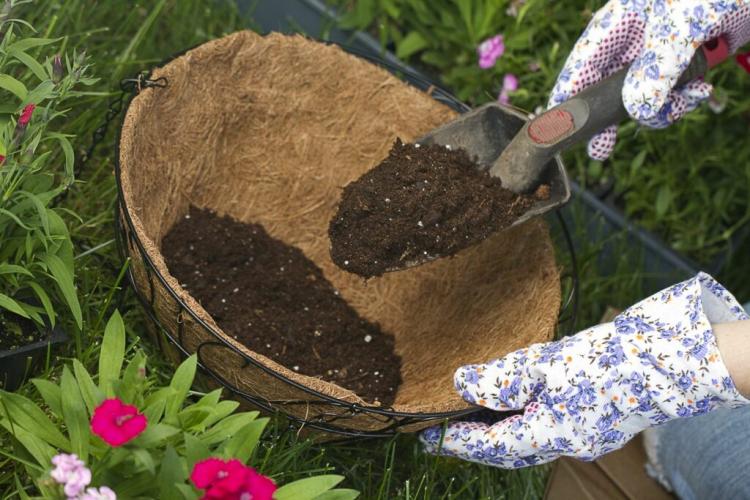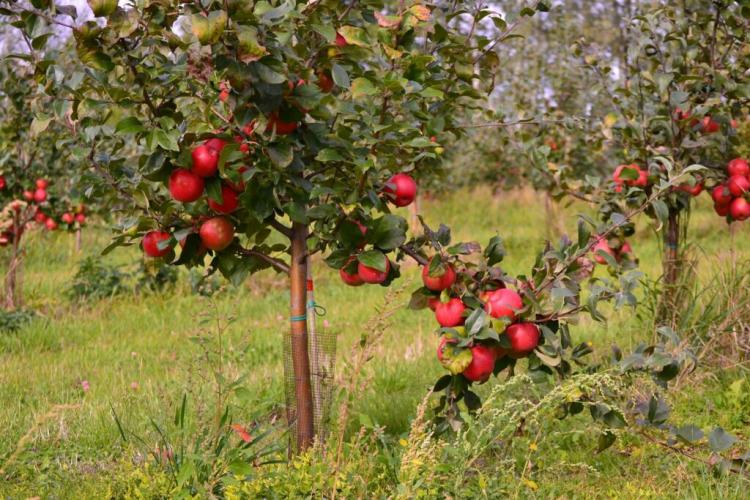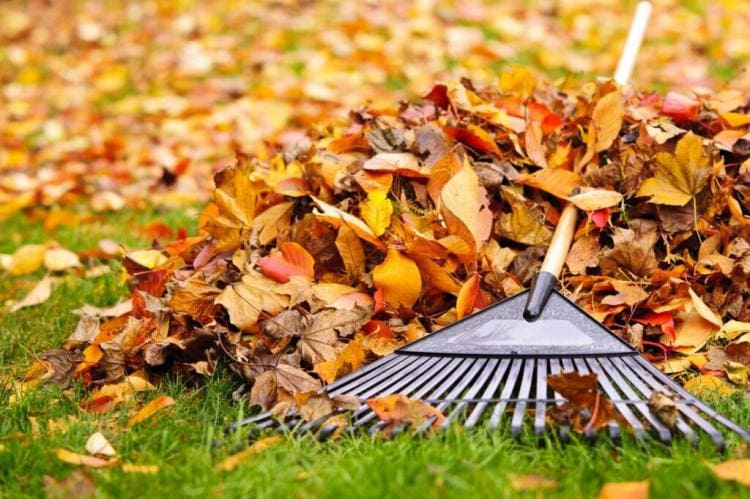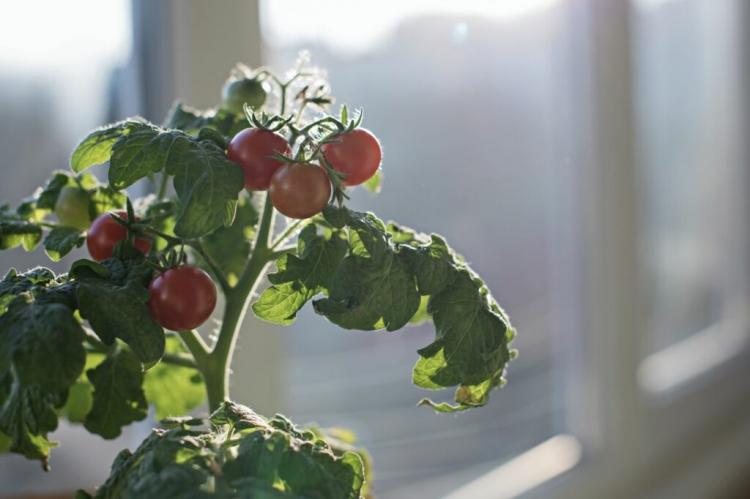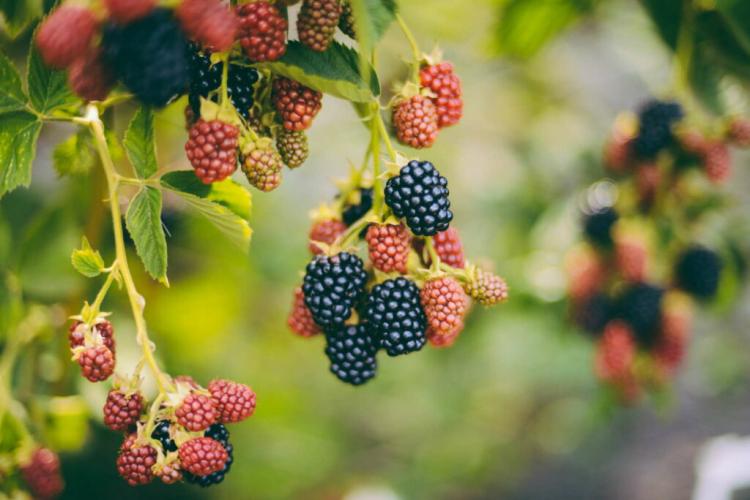Strongylodon
The exotic Strongylodon is part of the legume family. This plant is appreciated for its spectacular flowers of an unusual turquoise hue, which are collected in large racemose inflorescences. Such a vine in length can reach about 20 m. In an adult bush, the base of the trunk in diameter can reach 65 mm. The triple sheet plates have a glossy smooth surface.
Liana blooms in spring and fades – in the last days of August. Strongylodon is a fast-growing plant. If you create optimal conditions for growth, then in the first year of life in a week and a half, its growth can be about 6 m. Liana comes from the Philippine Islands. In natural conditions, it is very rare and is on the verge of extinction. It is rather difficult to grow this perennial indoors. For this, a florist will need a certain skill and knowledge. The bush blooms only after it turns 2 years old.
Brief Description Of Cultivation
Table of Contents
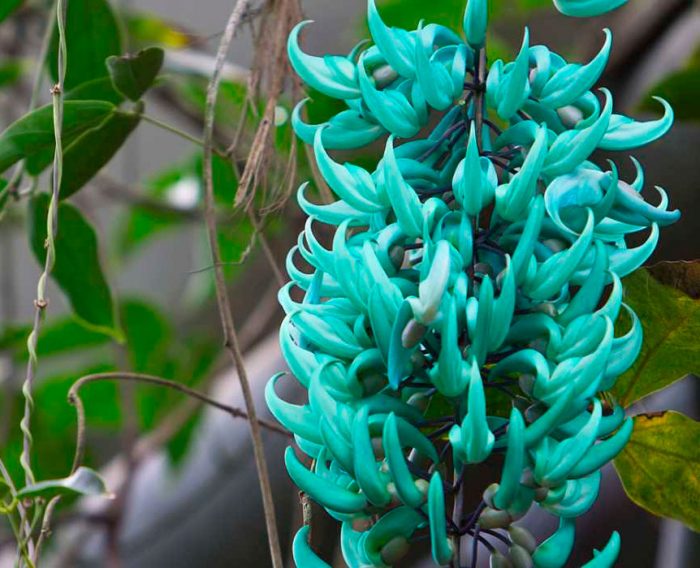
- Temperature. The plant needs warmth at any time of the year (from 22 to 30 degrees).
- Air humidity. Should be elevated. It is recommended to regularly moisten the bush with a sprayer.
- Illumination. Needs lots of bright light.
- Watering. Moisten the substrate abundantly, but only after its top layer dries slightly.
- Substrate. A peat-based soil mixture is used, which contains a large number of nutrients.
- Fertilizer. They are fed in spring and summer once every two weeks.
- Transplant. Young bushes are transplanted regularly once a year, and adults and old ones – once every few years, if necessary.
- Reproduction. Stem cuttings and seed method.
- Features of care. Liana needs reliable support.
Strongylodon Homecare

Indoor Strongylodon is quite picky about growing conditions and care. It is very sensitive to the level of humidity in the air and is susceptible to fungal diseases.
Bloom
For the first time, the bush blooms in the second year of growth, but only if its trunk is 20 millimeters or more across. Hanging racemose inflorescences can be up to 300 cm long. The maximum number of turquoise flowers in one inflorescence is about 100. The size of a flower can vary from 7 to 10 centimeters. If the flowers are pollinated, then at the end of flowering, fruits will form in their place, which is beans, reaching about 50 mm in length.
To achieve a lush bloom, a plant needs good care. Particular attention should be paid to lighting, which must be intense. Do not forget to feed the vines on time, using a mineral complex for flowering plants. You will also need to install high-quality high-strength supports for both stems and massive inflorescences.
Temperature
Such an exotic liana does not have a pronounced rest period. In this regard, all year round, the indoor temperature should be at the level of 22-28 degrees. If the room is cooler than 20 degrees, then the risk of fungal diseases affecting the bush increases.
Air humidity level
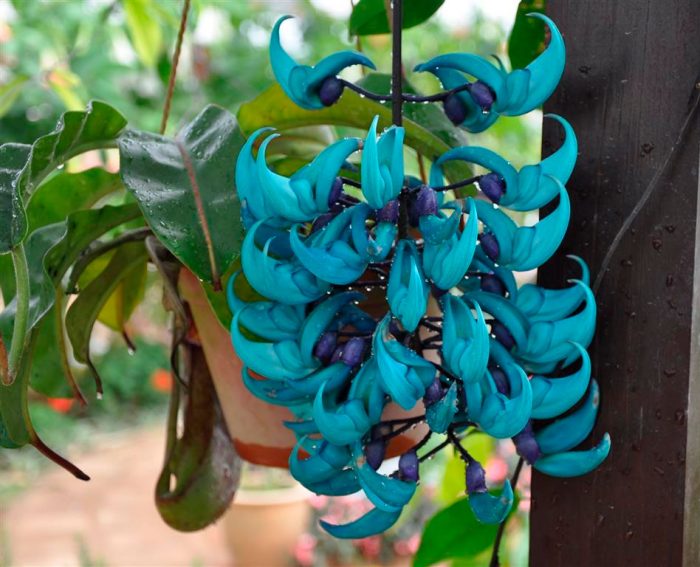
Indoor Strongylodon needs high air humidity. To increase the humidity, the flower pot is placed on a deep tray, into which pre-moistened pebbles or sphagnum are placed. If there is a need for this, then the liana is moistened every day from a spray bottle with well-settled non-cold water.
Watering
This “exotic guest” needs regular, abundant watering, which should be done quite often. However, make sure that moisture does not stagnate in the root system, as this can lead to the development of the fungal disease.
Water for moistening the substrate in the pot is used extremely soft, while its temperature should be slightly higher than room temperature. Since Strongylodon does not have a dormant period, it is watered in winter in the same way as in summer.
Pot
The root system of this vine is well developed and very powerful. It is growing relatively quickly in volume. That is why for planting a bush, you should take a tall and rather wide pot made of ceramics or strong plastic. There must be drainage holes at the bottom of the container.
Soil mixture
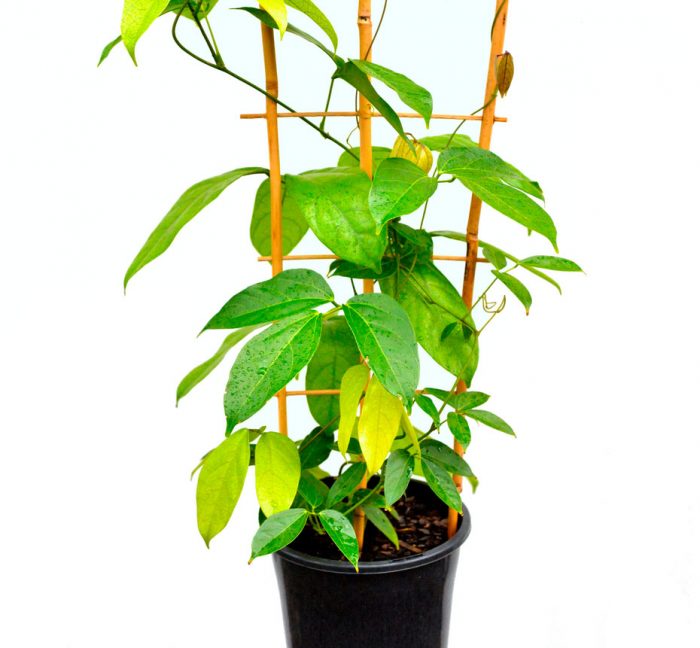
To grow this plant, a soil mixture rich in nutrients is used. To prepare it, it is necessary to combine humus, peat, and sand in a 1: 1: 1 ratio. Do not forget to make a good drainage layer at the bottom of the container, for this you can use expanded clay.
Fertilizer
Strongylodon is fed throughout the entire period of active growth. The frequency of feeding is 2 times a month. To do this, use a universal mineral complex fertilizer for flowering crops, while for the preparation of a nutrient solution, take ½ part of the dose recommended by the manufacturer (see the package). The nutrient solution is added to the soil mixture after preliminary watering.
Transfer
An adult Strongylodon is a fairly large plant with an impressive mass, so such bushes are transplanted only when absolutely necessary. If the plant is very large, then it is not transplanted, but simply the top layer of the soil mixture in the pot is replaced annually with fresh substrate. While the liana is young, it is transplanted once a year in the spring.
Dormant period
There is no dormant period for such an exotic plant. In winter, it is looked after in the same way as in summer.
Reproduction methods
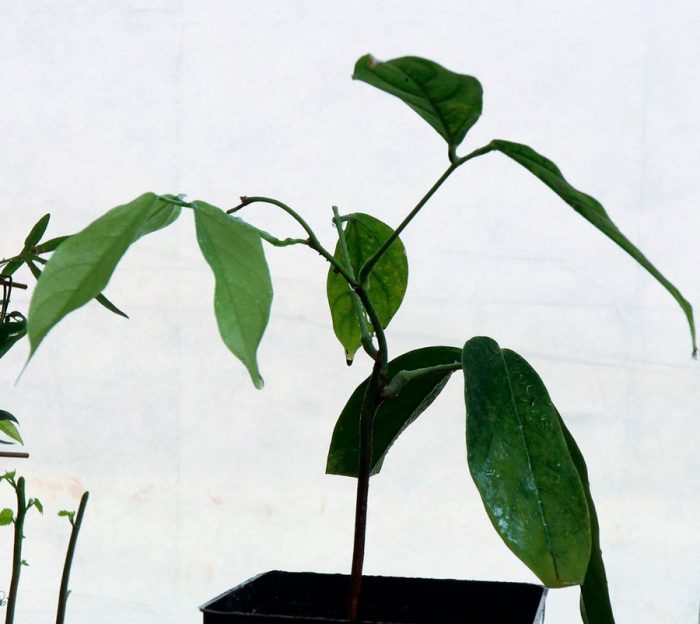
Growing from seeds
Once the Strongylodon seeds are harvested, they should be sown immediately into the substrate, otherwise, they will not sprout. The fact is that they rather quickly lose their germination. Before proceeding with sowing, the seeds must be scarified and immersed for a while in cold water, in which the drug that stimulates growth is previously dissolved. Sowing seed material is carried out in a container filled with peat and sphagnum. After about a week and a half, the first seedlings should appear.
Cuttings
For the propagation of these vines, stem cuttings are used. They are harvested in the spring. Before planting for rooting, it is necessary to process the cut points with Kornevin powder. To increase the chance of roots appearing on the cuttings, after planting they are provided with high air humidity and bottom heating.
Mini greenhouses are used to root Strongylodon cuttings. They should be placed in a bright and warm place. Rooting segments are planted in a mixture of peat and sphagnum. Under optimal conditions, the roots appear on the cuttings after about 1.5 months.
Potential issues
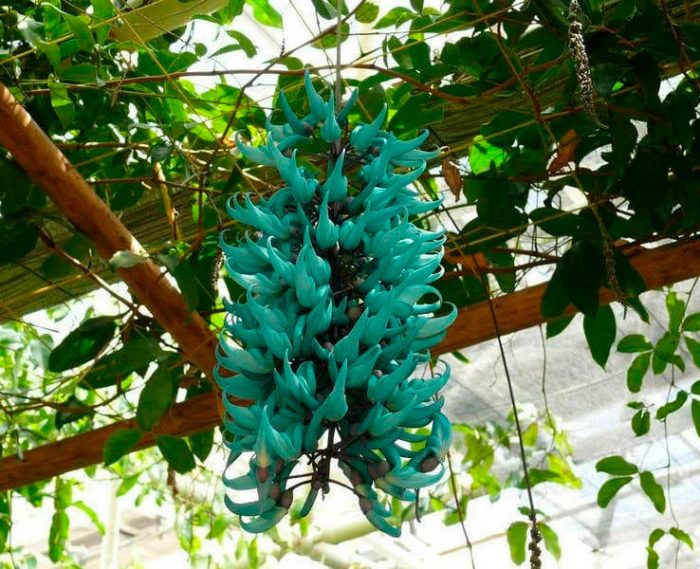
If Strongylodon is not properly cared for, then various problems can arise with it:
- Brown specks appear on the surface of the foliage. These are signs of a fungal disease that appears due to stagnation of moisture in the substrate. Check the bottom of the pot for drainage and holes.
- The foliage becomes dark. Too poor watering. It is required to revise the irrigation regime.
- Pests. Mealybugs, spider mites, and aphids most often inhabit this vine.
Strongylodon species with photo
Strongylodon macrobotrys

In nature, the species is found along rivers, streams, in lowlands, as well as in other places where there is high humidity. This Strongylodon is often grown as an ornamental plant. Under indoor conditions, with proper care, the length of its stems can reach two tens of meters.
Triplet smooth leaf plates have a bright green color. The shape of the flowers is similar to large butterflies that have folded their wings. For the first time, the bush blooms only in adulthood. The fruit is a pod with 10 to 12 seeds.
Strongylodon ruber
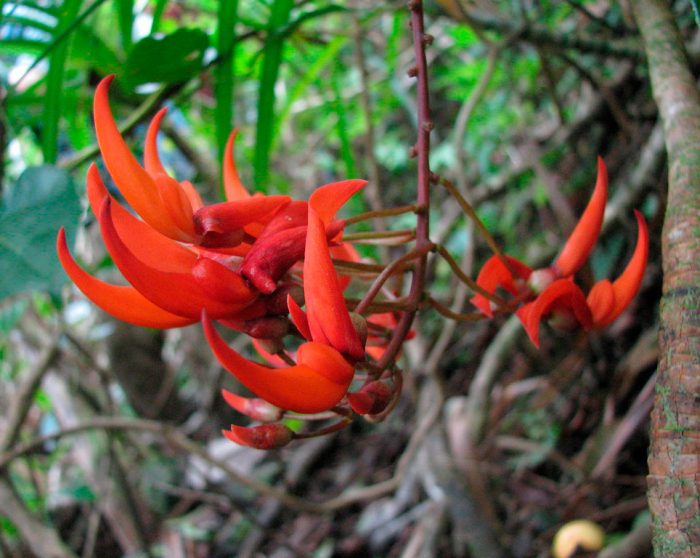
A large, powerful plant with developed and strong stems, which can reach more than 15 m in length. In nature, it is most often found in dense forests with small rivers and streams. The shoots of the species rise along tree trunks as if along supports, to a decent height. Brush-shaped inflorescences are composed of red flowers. This plant is a typical endemic because it is found naturally only in the Philippine archipelago.
Interesting Facts
Strongylodon is popularly referred to as the “jade flower”. Interesting Facts:
- The flowers of this liana have an unusual luminescent effect. Because of what they glow at night.
- In nature, Strongylodon is pollinated by bats.
- During the first year of life, the daily growth of a vine can be more than 50 cm.
- Where this liana comes from, it is considered a rather rare plant.
